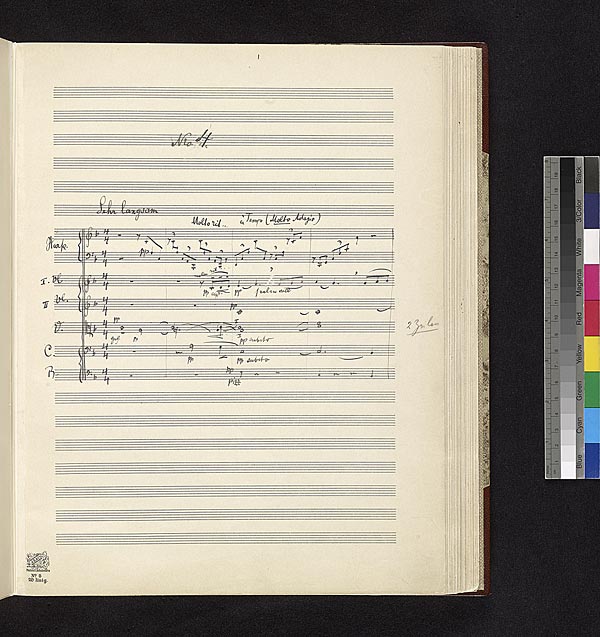- F major.
- Willem Mengelberg (1871-1951) wrote notes on “Spitzentechnik” on the front cover of the score of symphony no. 5, a technique for the strings, writes Mengelberg, which must be used in all symphonys of Gustav Mahler, and of which it is important that all strings do this. His notes to the Adagietto are the key to a good understanding of the music.
The third part of the symphony starts with the fourth movement, a tender Adagietto, one of the most intimate compositions of Mahler and certainly therefore one of the most famous, but also because Visconti used it in his film Death in Venice. After the rather trivial Scherzo, we encounter emotion and sensuality, it is pure poetry transformed into music.
Part III: Movement 4: Adagietto. Sehr langsam.
One feels that after the Scherzo, there was a rupture out of which a new start arises and thus the Adagietto becomes the prelude of the last movement. The orchestration is in no way inferior to the tenderness of the composition divided in three parts: Strings are exclusively used to play a clear and longing tune accompanied by a harp playing in a way the role of a Basso Continuo. In the middle part, a bit more vivid, where the harp is missing, the accessory theme of the Finale is introduced. After the Glissando of the culminating point, the harp returns and the yearning tune reaches its highest emotion before the Adagietto softly dies away.
Movement 4: Adagietto. Sehr langsam. First page of Willem Mengelberg (1871-1951)‘s score.
The expressive tenderness and romance of this movement claim especially a strict and restrained interpretation in order to put into value the beauty of this music without getting mawkish. Unfortunately, not all orchestras are able (or willing?) to do so.
More
The fourth movement may be Mahler’s most famous composition and is the most frequently performed of his works. The British premiere of the Fifth Symphony came thirty-six years after that of the Adagietto, conducted by Henry Wood at a Proms concert in 1909. Leonard Bernstein (1918-1990) conducted it during the funeral Mass for Robert Kennedy at St. Patrick’s Cathedral, New York, on 8 June 1968. It was used in the 1971 Luchino Visconti film Death in Venice.
It is said to represent Mahler’s love to Alma. According to a letter Alma wrote to Willem Mengelberg, Mahler left a small poem:
“Wie ich dich liebe, Du meine Sonne,
ich kann mit Worten Dir’s nicht sagen.
Nur meine Sehnsucht kann ich Dir klagen und meine Liebe.”
“How much I love you, you my sun,
I cannot tell you that with words.
I can only lament to you my longing and love.”
It lasts for approximately 10 minutes, and Mahler’s instruction is sehr langsam (very slowly). Mahler and Mengelberg played it in about 7 minutes. Some conductors have taken tempos that extend it to nearly 12 minutes (viz. recordings by Eliahu Inbal, Herbert von Karajan and Claudio Abbado (1933-2014)), while Simon Rattle with the Berlin Philharmonic Orchestra performed it in 9½ minutes.
Leonard Bernstein (1918-1990) also briefly discusses this section along with the opening bars of the 2nd movement in his Charles Eliot Norton lectures from 1973.
Listening Guide

